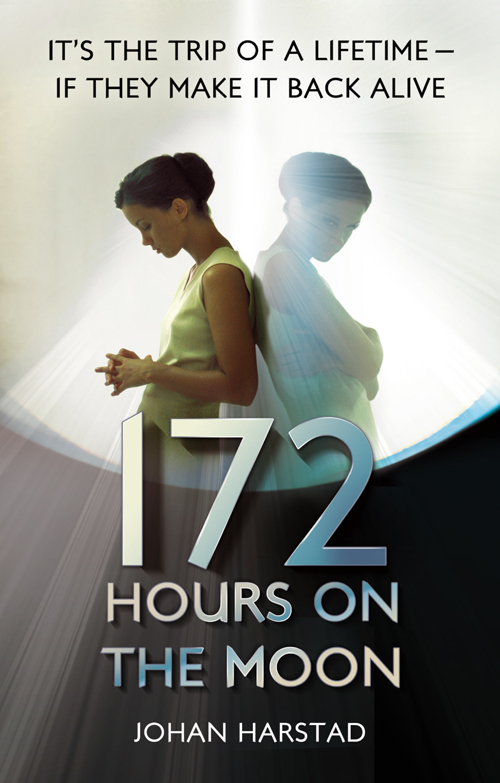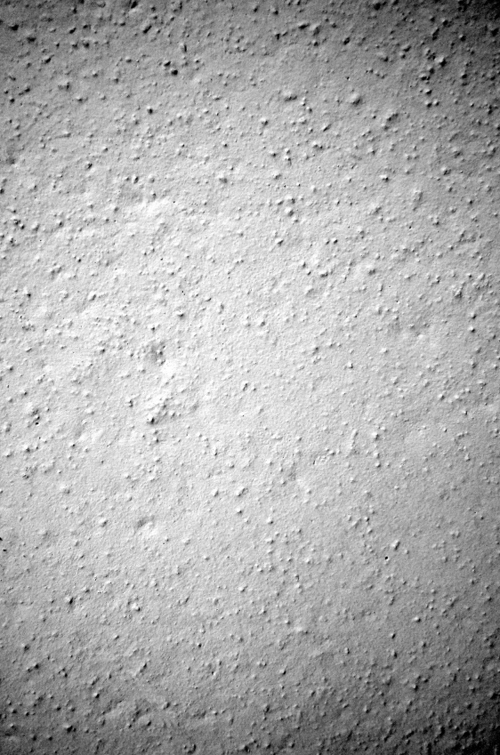172 Hours on the Moon
Read 172 Hours on the Moon Online
Authors: Johan Harstad


Published by Hachette Digital
ISBN: 9781405512596
Copyright © 2008 CAPPELEN DAMM AS
English translation copyright © by Tara F. Chace
This translation has been published with the financial support of NORLA.
The moral right of the author has been asserted.
All characters and events in this publication, other than those clearly in the public domain, are fictitious and any resemblance to real persons, living or dead, is purely coincidental.
The NASA “Return to the Moon” artwork is intended to represent a fictional and futuristic organization and is in no way intended to imply any endorsement by or affiliation with the National Aeronautics and Space Administration.
Image Credits:
Pages
v
,
13
,
120
,
157
,
242
,
248
,
320
,
330
,
341
,
353
: NASA/courtesy of
nasaimages.org
Page
34
: Ryan McVay/Getty Images; © Getty Images
Pages
51
,
52
,
89
,
123
,
341
: © LACKTR
Pages
107
,
113
: © John Erik Riley
Pages
191
,
192
,
280
: © Rodeo Architects
Page
259
: ESA – European Space Agency
Page
276
: The Ohio State University Radio Observatory
The photograph on page
259
is an artist’s impression. The size of the debris is exaggerated as compared to Earth.
All rights reserved.
No part of this publication may be reproduced, stored in a retrieval system, or transmitted, in any form or by any means, without the prior permission in writing of the publisher, nor be otherwise circulated in any form of binding or cover other than that in which it is published and without a similar condition including this condition being imposed on the subsequent purchaser.
Hachette Digital
Little, Brown Book Group
100 Victoria Embankment
London, EC4Y 0DY

“Gentlemen, it’s time,” Dr.
said, eyeing the seven men in suits seated around the large conference table. They were some of the most powerful people
in the country, together in the largest meeting room at NASA headquarters in Washington, D.C. It was nearing eleven o’clock
at night.
They would have to make a decision soon.
“So, what’s it going to be, then?” Dr.
asked impatiently.
The cigarette smoke in the room was thick and impenetrable, making the atmosphere even gloomier. All rules forbidding smoking
in government offices had fallen by the wayside as nerves came to a head.
“Well,” one of the seven began, chewing on his pencil, “it’s an
incred ibly risky proposition. You must know that. Is it really worth it?”
“People had already completely lost interest in the moon missions before the last launch in 1972,” another one said. “Why
do you think they’d be on board with us going back?”
“It could be done,” a third said. “We could tell them there’s a good chance of finding large amounts of tantalum seventy-three
at the moon’s south pole.”
The room was suddenly buzzing, the tension starting to crescendo.
“You don’t want to go back to the south pole, trust me.”
“Of course not.”
“It’ll kill you.”
“I’m aware of that.”
“If you ask me, I say leave the whole place alone.”
“Gentlemen,” Dr.
interrupted, “do you have any idea how important a discovery tantalum seventy-three would be? Most current technology is
dependent on this material. People would be throwing money at us.”
“So we’re going up there to search for natural resources? I thought —” one of the other men said.
Dr.
interrupted him again. “No, we’re not.”
The chairman of the Joint Chiefs of Staff cleared his throat. “Let me put the cards on the table for you, gentlemen. We are
not going to the south pole of the moon, and whether or not tantalum seventy-three is found on the moon is completely immaterial.”
Confusion spread through the room.
“I presume some of you are familiar with Project Horizon?” he continued.
The man who had spoken first asked, “You mean the research done in the late fifties? The plans to build a military base on
the moon? I thought that was scrapped.”
Dr.
shook his head. “The base isn’t military.” He looked at the chairman of the Joint Chiefs. “It’s just a research station.
Isn’t that right?”
The chairman didn’t answer. He gave the man a friendly look. “It’s called DARLAH 2. It was constructed in the seventies under
the name Operation DP7.”
“But why … in the world … why haven’t any of us heard of it before?”
“All information concerning DARLAH 2 was classified top secret until just recently. For security reasons.” He paused for a
second, pondering whether or not he ought to say any more.
Dr.
beat him to it, explaining, “DARLAH 2 was built from 1974 to 1976. But the base is in the Sea of Tranquility, where, as you
know, Armstrong and Aldrin originally landed in sixty-nine. None of the other landings occurred there.”
“Why was it built?” one of the men who had been quiet up until that point asked.
“We found something,” Dr.
replied.
“Could you elaborate?”
“We don’t know what it is. The plan was to continue our studies and station personnel on the moon, but as you already know,
after 1976 we lost most of our funding. And as I hinted, finances weren’t the only reason the moon program was terminated.
The truth is that … what we found up there is not the type of discovery for which one receives money for further research.
We
would have been asked to leave it alone. So we pretended it never existed … and, anyway, the signal disappeared.”
“Until it showed up again last fall,” the chairman of the Joint Chiefs added.
“The
signal
?
It?
What the hell is
it
?” one of the confused men exclaimed. Dr.
looked at the man who had spoken, then leaned over and pulled something out of his briefcase. He set a folder on the table
and pulled out a four-by-six photo.
“This picture was taken on the moon by
Apollo 15
’s James Irwin. The astronaut in the photo is David R. Scott.”
“But … who’s the other person in the background?” one of the men asked.
“We don’t know.”
“You don’t
know
? What the hell is going on here?”
“There’s a proper time for everything, gentlemen. All the information you’re asking for will be made available once we’ve
unanimously voted to proceed with the plan — which, may I remind you, the president himself is in full support of. Now, can
we discuss how we’re going to explain the fact that we’ve had an unused base sitting up there for forty years without anyone
finding out about it?”
“Unused? Are you trying to say that no one has ever stayed at this base before?” one of the astronauts in the room asked.
“What about the people who built it?”
“They were never inside. The modules were assembled on the surface by machines, not by people.”
One of the men already on board with the plan stood up, smiling confidently: “We’ll say we’ve spent forty years testing it,
making sure it works perfectly.”
“And does it?” someone else asked.
“In principle, yes,” replied the man, whose smile wasn’t quite so confident anymore.
“
In principle
isn’t good enough, is it?”
“It’ll have to do. We have to go back within a decade, before someone else gets there first.”
Several of the men present still seemed skeptical, if not stunned.
“But who are you going to send up there? What are they going to do?”
“The first expedition will accomplish three simple things. One: They’ll test the base and make sure it’s working the way it’s
supposed to. Two: They’ll research the possibility of mining rare Earth metals that will give the United States a huge advantage
in the technology manufacturing market. And three — this is the most important of all, gentlemen — they will attract media
attention, which will consequently secure sufficient financial support to continue our research and … get rid of any potential
… problems.”
“Problems like what?” someone asked.
Dr.
held his hand up in front of him as if to stop the words. “As I said, we’ll get to that. The idea is to turn the whole thing
into a celebration of the fiftieth anniversary of the first manned mission to land on the moon. We’ll build new, improved
versions of the classic Apollo program rockets from the sixties and seventies. That’s guaranteed to make people feel nostalgic.”
“But no one under the age of forty-five even remembers those Apollo missions.”
Dr.
waited a long time before speaking. He was a very intelligent man, and having to explain every detail to these ludicrous
excuses for public figures was grating on his nerves. Fortunately, he had played this conversation out in his head many times,
and he had an answer for anything they might ask, including the perfect idea for getting the entire
world
interested in a new mission. “Gentlemen, what if we send some teenagers up there?”
No one responded. They all just sat there, waiting, assuming he was joking.
But he wasn’t.
“You want to send
kids
? Why in the world would you want to put kids on the moon?” someone asked.
Dr.
smiled patronizingly and replied, “If we select three young people, teenagers, who get to accompany the astronauts, we’ll
get a whole new generation excited about space exploration. It will be nothing less than a global sensation.”
“But … just a minute ago you were telling us there’s something …
unknown
up there. And none of you seem able to say what it really is or what potential consequences we’re facing. And you want to
send untrained, innocent teenagers up there as, what,
guinea pigs
?”
“The benefits outweigh the risks,” Dr.
replied. “The probability of anything happening is small in the specific area of operation, and the astronauts will have
the opportunity to set up important equipment and perform the necessary studies. For the sake of simplicity, I think it’s
best to look at this as two missions in one. The first — our part — is to research the potential mining of tantalum seventy-three
—”
“I thought you said we would not actually look for tantalum at all?”
“We won’t.” Then he went on. “The second part will be the teenagers’ mission, which will be little effort for them. The media
attention will be automatic. They’ll portray this as a glamorous space version of a trip to Disneyland. And, best of all,
my preliminary inquiries indicate that some major corporate sponsorship is almost guaranteed, which will likely provide the
money we need for a second mission.”
“There’ll be a second mission as well?”
“I’m afraid so.”
“You want kids to go on the second one as well?”
“No.”
Dr.
held up two thick envelopes marked
TOP SECRET
. “Teenagers on the moon, gentlemen, is the solution we’ve been looking for. The door opener.”
“But how will you decide who gets to go?”
Dr.
smiled again, even more slyly, and replied, “We’ll hold a lottery.”